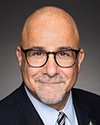Thank you for your time.
Evidence of meeting #5 for Science and Research in the 44th Parliament, 1st Session. (The original version is on Parliament’s site, as are the minutes.) The winning word was support.
A recording is available from Parliament.
Evidence of meeting #5 for Science and Research in the 44th Parliament, 1st Session. (The original version is on Parliament’s site, as are the minutes.) The winning word was support.
A recording is available from Parliament.
Liberal

The Chair Liberal Kirsty Duncan
With that, we will now go to our round of questioning. This is a six-minute round and we will begin with Tony Baldinelli.
Conservative

Tony Baldinelli Conservative Niagara Falls, ON
Thank you, Madam Chair. It is good to have you back in the chair.
To all the witnesses, thank you for being here this evening.
Over the previous meetings, we've heard a number of witnesses talking about the importance of the ecosystem foundation as being critical to science, research and innovation. In fact, we've heard from them of the need for discussions on the greater need for harmonization, collaboration and coordination.
Mr. Naylor, in the fall of 2017, the Canada Research Coordinating Committee was established with a mandate of greater harmonization, integration and coordination of research-related programs and policies to address issues of common concern. At the same time, in the spring of 2017, there was also the Naylor report, and one of its recommendations was the creation of a national advisory council on research and innovation.
I just want to get your opinion. Do you believe the creation of that CRCC is essentially what you or the Naylor report had been recommending?
Professor, University of Toronto, As an Individual
We did recommend the creation of such a coordinating committee, and I think we're very grateful that the minister, now in the chair, moved quickly to get that established.
The question that really needs some sounding across the country in the research community is whether the current structure is coordinating as well as might be hoped. I fully acknowledge that my colleagues have made progress. Things such as TAIPR, the streamlined peer review for transdisciplinary research, are impressive.
I would note, however, referring to the new frontiers fund, it was actually part of the budget that the minister and others brought down that anticipated that fund. It's very important to understand that some of this is simply executing on that which was put in place at the transdisciplinary level. That's that side of it.
I would think the coordination function needs a close look, but part of the reason we recommended a second body, an oversight body, was for just that reason, to provide that court of sober second opinion on how things were evolving but also, from the standpoint of an ecosystem, to make sure that innovation was linked to the science and research.
Professor, University of Toronto, As an Individual
This was to be a committee focused on research and innovation, not on research alone. We see a need for both.
Thank you very much.
Conservative

Tony Baldinelli Conservative Niagara Falls, ON
Thank you.
I have one quick question to you. I also keyed in on your recommendation 4.11 about the government undertaking a comprehensive review to modernize, and where possible, harmonize the legislation of the four agencies.
Are we aware, maybe even our chair as well, whether that was ever done?
Professor, University of Toronto, As an Individual
I don't think it was ever done, and I think you'll find that it might be something to be thought about if there were to be a review of how the coordination has gone.
Obviously the colleagues are collaborating very well. You don't want structure to supersede just good collaboration and common sense. However, I still believe that review is appropriate.
Conservative

Tony Baldinelli Conservative Niagara Falls, ON
Thank you for that. I just find that it has been five years and we continue to hear this notion of the ecosystem and needs for collaboration and harmonization, so I wonder if we're failing in some area. We've heard from certain witnesses that the systems can be cumbersome and bureaucratic. In fact, one witness talked about the whole notion of a “one-stop shop” idea.
I'll go to Dr. Mossman now, because unfortunately she didn't have a chance to finish on that whole notion about the ecosystems. You talked about new solutions and approaches, and you talked about the nexus model. Could you quickly expand on that a bit?
After that, I'd like to get to Mr. Kenyon, of Brock University, as well for one question.
Vice-President, Research, McMaster University
The question is on the Nexus ecosystem.
The idea is to pull together, not just multidisciplinary across multiple universities, but across sectors within public health to have that coordination, so we understand what....
Something like a pandemic is a very complex problem and it requires complex solutions. It requires coordination not just amongst academics, but with our industry partners, government partners, and policy-makers, so we can quickly understand what all the issues are and rapidly mobilize all of the expertise that we have in all these sectors across the country.
Conservative

Tony Baldinelli Conservative Niagara Falls, ON
Thank you.
I'd like to go to Mr. Kenyon now.
I latched on to your comments about medium and smaller research taking place at some of these universities such as Brock. I really enjoyed your line about enhancing the cultural and economic vitality of our communities and the impact it has.
I'll use Niagara as an example. I am wondering if you could expand on the establishment of the Cool Climate Oenology and Viticulture Institute and what it has meant to our grape and wine sector.
Vice-President, Research, Brock University
Through you, Madam Chair, the Cool Climate Oenology and Viticulture Institute is a great example of what we're talking about. A program like Vine Alert, which uses sophisticated meteorological and real-time monitoring of grapevine bud conditions, enables grapevine farmers to know when to turn on their wind machines in the winter. Right now is a great example to reduce losses of grapevine to cold weather. This enables them to save, on a conservative estimate, a million dollars a year collectively in propane costs alone by not having to turn the machines on needlessly.
To put something like that in place you have to be brilliant, you have to be creative, but you also have to be here.
If you're not here, you don't do it.
Liberal

The Chair Liberal Kirsty Duncan
Dr. Kenyon, that was a short answer.
Mr. Baldinelli, thank you for your questions and thank you to the witnesses who answered.
We will now go to Mr. Chad Collins for six minutes.
Liberal

Chad Collins Liberal Hamilton East—Stoney Creek, ON
Thank you, Madam Chair.
I would like to direct my questions to Dr. Mossman and Dr. Wright from a parochial perspective.
Through the pandemic, I think we've all learned about the importance of making strategic investments in science and research. It's these past investments that have been made in the field that have helped us get through the pandemic and get us to where we are today.
I listened with interest about the nexus project. I thought I heard the reference to an inhalable vaccine for COVID.
Through you, Madam Chair, could either Dr. Mossman or Dr. Wright further elaborate on the nexus model and the reference to the inhalable vaccine?
Vice-President, Research, McMaster University
Sure. I can certainly take that.
The inhaled vaccine really builds on the expertise that we have at McMaster in adenovirus-based technology. The adenovirus-based technology is actually McMaster's solution from many years ago. We also have deep expertise in mucosal immunity. This stems from past research in tuberculosis.
Putting all that expertise together, we came up with a new inhaled type of vaccine that gets directly into the lungs and the mucosal surfaces where we know it is more efficacious. It also is different in that it has three different proteins—not just against spike, but also against two other conserved proteins. This will allow it to provide immunity against variants of concern or even new coronaviruses. Because of the nature of it being an inhaled vaccine, it only requires about 1/100th of the dose. From a manufacturing perspective, this gives a great advantage.
This is all from past investment in our GNP facility and from the research within our group that we were able to develop this really new type of technology.
Liberal

Chad Collins Liberal Hamilton East—Stoney Creek, ON
Thanks, Dr. Mossman.
You emphasized, Dr. Mossman, about how the nexus project differs from the existing research ecosystem in Canada. You reference—I specifically wrote it down—that the right amount of funding will get us to the next stage with nexus.
Can you elaborate and further explain how nexus differs from the existing research ecosystem? What amount of funding were you referencing in your opening statement in that regard?
Vice-President, Research, McMaster University
Our entire nexus project is around $400 million, but I'm actually going to let Gerry, who is the lead of nexus, talk about the unique ecosystem.
Dr. Gerry Wright Director, Michael G. DeGroote Institute for Infectious Disease Research, and Lead, Canada's Global Nexus for Pandemics and Biological Threats, McMaster University
Thank you very much.
Thank you for the question. I'm really happy to tell you a bit more about it.
First, the nexus initiative is really built on our experience in the Institute for Infectious Disease Research over the last almost 20 years, where the emphasis really has been on interdisciplinary teamwork and bringing people together across disciplines that don't normally work together and providing rewards for doing so.
Some of those are obviously financial rewards that are enabled, frankly, by very generous philanthropic gifts that have pioneered our ability to do this cross-disciplinary work. As you've heard, it is very challenging in the Canadian system to foster that, frankly, and it is in fact very challenging to foster that in the university system, because the rewards are primarily individual.
The nexus initiative is really built to be able to bridge all of those gaps through the development of teams and through the development of pre-existing collaborations and, as Dr. Mossman said, both within the university and with our partners in industry, government and not-for-profit agencies across the globe. That really provides us an opportunity to do truly agile interdisciplinary work that is directly focused on impacts.
Liberal

Chad Collins Liberal Hamilton East—Stoney Creek, ON
My final question, through you, Madam Chair, would be about this. In my time as a councillor in Hamilton, I had the honour and the privilege of working with McMaster University and other partners to bring the David Braley Health Sciences Centre to downtown Hamilton. I believe there were 400 positions that came with that new building and with the investment that the city and the province supported. I believe we had a philanthropic donation from Mr. Braley on that one as well.
That brought many funding sources together. I think one of the goals and objectives was to retain some of the talent that is making its way through McMaster and some of our other institutions, not just in Ontario but across the country.
Dr. Wright, can you expand upon how nexus will help us retain Canada's top talent, not just with your project here, but maybe in the city and beyond its borders?
Director, Michael G. DeGroote Institute for Infectious Disease Research, and Lead, Canada's Global Nexus for Pandemics and Biological Threats, McMaster University
Yes, I'd be delighted to.
We're very excited about the initiative, and we're purposely locating it at McMaster Innovation Park, where it is surrounded by opportunities to develop start-up companies and what have you.
Part of our goal is to provide a seamless opportunity to translate research from the laboratory into application by co-locating it in such an area. That will be a pretty significant issue. As Dr. Mossman indicated, the idea is picking up steam, and we actually have been able not only to retain but to repatriate three outstanding Canadian researchers from the United States, who are coming back to Canada, back to McMaster, to set up their laboratories to contribute to our Canadian research—
Liberal

The Chair Liberal Kirsty Duncan
It's so interesting.
Thank you, Mr. Collins.
We will now go to Monsieur Blanchette-Joncas for six minutes.
Bloc

Maxime Blanchette-Joncas Bloc Rimouski-Neigette—Témiscouata—Les Basques, QC
Thank you, Madam Chair.
I want to start by welcoming our second panel of witnesses this evening.
My first questions are for Dr. Naylor.
Dr. Naylor, thank you for being here.
In less than two months, it will have been five years since you chaired the Advisory Panel for the Review of Federal Support for Fundamental Science. The panel's report, commonly referred to as the Naylor report, laid the groundwork for a strategy aimed at increasing research investment, achieving better coordination across the four granting agencies, and creating a national advisory council on research and innovation.
The report contained numerous recommendations. Do you think the measures the government has taken since the report came out are enough? Will Canada be able to make up for decades of lost ground in the research and innovation sector?